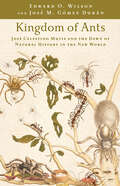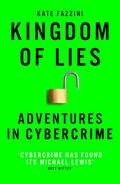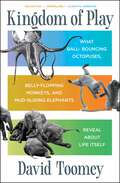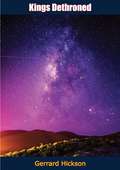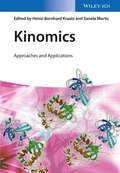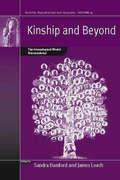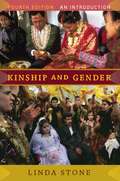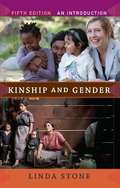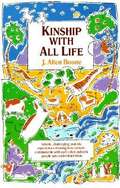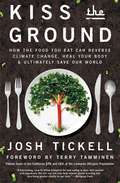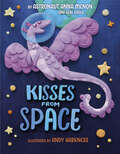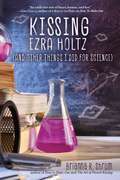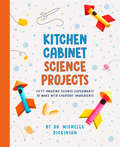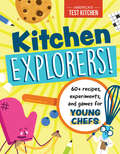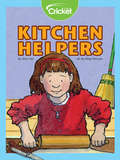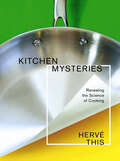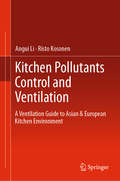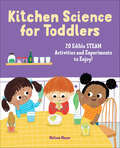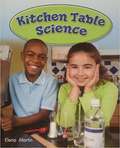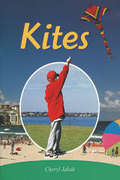- Table View
- List View
Kingdom of Ants: José Celestino Mutis and the Dawn of Natural History in the New World
by Edward O. Wilson José M. DuránOne of the earliest New World naturalists, José Celestino Mutis began his professional life as a physician in Spain and ended it as a scientist and natural philosopher in modern-day Colombia. Drawing on new translations of Mutis's nearly forgotten writings, this fascinating story of scientific adventure in eighteenth-century South America retrieves Mutis's contributions from obscurity.In 1760, the 28-year-old Mutis—newly appointed as the personal physician of the Viceroy of the New Kingdom of Granada—embarked on a 48-year exploration of the natural world of northern South America. His thirst for knowledge led Mutis to study the region's flora, become a professor of mathematics, construct the first astronomical observatory in the Western Hemisphere, and amass one of the largest scientific libraries in the world. He translated Newton's writings and penned essays about Copernicus; lectured extensively on astronomy, geography, and meteorology; and eventually became a priest. But, as two-time Pulitzer Prize–winner Edward O. Wilson and Spanish natural history scholar José M. Gómez Durán reveal in this enjoyable and illustrative account, one of Mutis's most magnificent accomplishments involved ants. Acting at the urging of Carl Linnaeus—the father of taxonomy—shortly after he arrived in the New Kingdom of Granada, Mutis began studying the ants that swarmed everywhere. Though he lacked any entomological training, Mutis built his own classification for the species he found and named at a time when New World entomology was largely nonexistent. His unorthodox catalog of army ants, leafcutters, and other six-legged creatures found along the banks of the Magdalena provided a starting point for future study.Wilson and Durán weave a compelling, fast-paced story of ants on the march and the eighteenth-century scientist who followed them. A unique glance into the early world of science exploration, Kingdom of Ants is a delight to read and filled with intriguing information.
Kingdom of Lies: Unnerving adventures in the world of cybercrime
by Kate FazziniWould you say your phone is safe, or your computer? What about your car? Or your bank? There is a global war going on and the next target could be anyone – an international corporation or a randomly selected individual. From cybercrime villages in Romania to intellectual property theft campaigns in China, these are the true stories of the hackers behind some of the largest cyberattacks in history and those committed to stopping them. You&’ve never heard of them and you&’re not getting their real names. Kate Fazzini has met the hackers who create new cyberweapons, hack sports cars and develop ransomware capable of stopping international banks in their tracks. Kingdom of Lies is a fast-paced look at technological innovations that were mere fantasy only a few years ago, but now make up an integral part of all our lives.
Kingdom of Play: What Ball-bouncing Octopuses, Belly-flopping Monkeys, and Mud-sliding Elephants Reveal about Life Itself
by David ToomeyThis &“delightful…compelling&” (Scientific American) and revelatory look at the science behind why animals play &“will fill you with joy and wonder&” (Sy Montgomery, author of The Soul of an Octopus).Acclaimed science writer David Toomey takes us on a fast-paced and entertaining tour of playful animals and the scientists who study them. From octopuses on Australia&’s Great Barrier Reef to meerkats in the Kalahari Desert to brown bears on Alaska&’s Aleutian Islands, we follow adventurous researchers as they design and conduct experiments seeking answers to new, intriguing questions: When did play first appear in animals? How does play develop the brain, and how did it evolve? Are the songs and aerial acrobatics of birds the beginning of avian culture? Is fairness in dog play the foundation of canine ethics? And does play direct and possibly accelerate evolution? Monkeys belly flop, dolphins tail-walk, elephants mud-slide, crows dive-bomb, and octopuses bounce balls. These activities are various, but all are play, and as Toomey explains, animal play can be defined as a distinct behavior that is ongoing and open-ended, purposeless and provisional—rather like natural selection. Through a close examination of both natural selection and play, Toomey argues that life itself is fundamentally playful. A &“lively, informative, and scientifically entertaining animal behavior study&” (Kirkus Reviews) Kingdom of Play is an illuminating—and yes, playful—look at a little-known aspect of the animal kingdom.
Kingdom of the Sun
by Jacqueline MittonChildren take a wondrous tour of our solar system in this stunning new book that weaves mythology and astronomy in magical ways. Jacqueline Mitton's poetic text explores each planet, comparing its features to those of the Roman god or goddess for whom it was named. Although this naming occurred long before humans had accurate information about the planets, the book points out some remarkable coincidences based on what we know today. The veiled goddess Venus, for example, lends her name to a cloud-veiled planet. And the blue, stormy planet Neptune is named for the god of the sea. This intriguing and highly informative book--a sequel to the same team's best-selling Zoo in the Sky--presents the most up-to-date, scientific details about the planets in an artful way that will stir the minds and imaginations of young readers.
Kings Dethroned: A History Of The Evolution Of Astronomy From The Time Of The Roman Empire Up To The Present Day; Showing It To Be An Amazing Series
by Gerrard HicksonAt the turn of the twentieth century, Gerrard Hickson stumbled upon a discovery which convinced him of something shocking. The giants of astronomy had miscalculated the distance of the sun from the Earth, it was closer than we ever thought. The popular estimate of approximately ninety-three million miles appeared to be a mistake, as inconceivable as it seemed.Hickson pored through the methods that his predecessors had used to calculate the distance and the accounts of their work, searching for the means to disprove his theory but instead he found a mistake in Dr. Hailey’s diurnal method. Invented by Hailey in the nineteenth century and used as a basis for many other calculations about our solar system.We can only imagine that Hickson must have gritted his teeth when he set himself the challenge of proving Dr. Hailey’s error. Kings Dethroned is the result of his research, and through his retracing of the steps of astronomers from the Roman Empire all the way up to the present day, we can see an accurate representation of the planets and our sun.Gerrard Hickson, unlike his predecessors, took his findings to the general public and published this book for the consumption of all. Having been rejected or ignored by experts and scientific societies across the western world, he chose to trust in the public. He felt that the truth and his discovery were the wealth of the whole human species and in this modern age it does the reader only good to contemplate the necessity of constant and honest scientific enquiry.
Kinomics
by Sanela Martic Heinz-Bernhard KraatzAuthored by the world's leading kinase experts, this is a comprehensive introduction to current knowledge and practice within this emerging field. Following an overview of the major players and pathways that define the kinome, the major part of this work is devoted to current strategies of kinome investigation and manipulation. As such, kinase engineering, peptide substrate engineering, co-substrate design and kinase inhibitor design are discussed in detail, and their potential applications in kinome analysis and kinome-based pharmacotherapy are shown. The result is a toolbox for every kinase researcher: By addressing and comparing current approaches to the study of kinase action, both novice and established researchers will benefit from the practical knowledge contained in this invaluable reference.
Kinship And Beyond
by Sandra Bamford James LeachThe genealogical model has a long-standing history in Western thought. The contributors to this volume consider the ways in which assumptions about the genealogical model--in particular, ideas concerning sequence, essence, and transmission--structure other modes of practice and knowledge-making in domains well beyond what is normally labeled "kinship." The detailed ethnographic work and analysis included in this text explores how these assumptions have been built into our understandings of race, personhood, ethnicity, property relations, and the relationship between human beings and non-human species. The authors explore the influences of the genealogical model of kinship in wider social theory and examine anthropology's ability to provide a unique framework capable of bridging the "social" and "natural" sciences. In doing so, this volume brings fresh new perspectives to bear on contemporary theories concerning biotechnology and its effect upon social life.
Kinship and Gender, 4e
by Linda StoneDesigned for undergraduate courses in kinship, gender, or the two combined, Linda Stone's Kinship and Gender is the product of years of teaching. The topic of kinship comes alive when linked to gender issues; conversely, the cross-cultural study of gender benefits from a working knowledge of kinship. This essential book successfully merges these two disciplines, demonstrating their relevance to students' lives and enhancing students' understanding of other cultures. Fourteen case studies throughout the book illuminate the intricate connections between kinship and gender across a variety of cultural groups. The fourth edition features a new chapter that reveals how kinship structures and related gender roles underlie many current social problems around the world. Also new to this edition are two original case studies, discussion questions, and listings of useful websites to aid further research.
Kinship and Gender, 5e
by Linda StoneDoes kinship still matter in today's globalized, increasingly mobile world? Do family structures continue to influence the varied roles that men and women play in different cultures? Answering with a resounding "yes!", Linda Stone offers a lively introduction to and working knowledge of kinship. She firmly links these concepts to cross-cultural gender studies, illuminating the malleable nature of gender roles around the world and over time.Written to engage students, each chapter provides key terms and useful generalizations gleaned through cross-cultural research on the interplay of kinship and gender in both traditional societies and contemporary communities. Detailed case studies help students understand how such generalizations are experienced "in real life." Stone also considers the ramifications of current social problems and recent developments in reproductive technology as she demonstrates the relevance of kinship and gender to students' lives.The fully-revised 5th edition features discussion of cross-cultural examples complimented by expanded coverage of kinship and gender dynamics within the United States. Stone considers current evolutionary research on kinship and gender, and offers new case studies addressing international adoptions and polygynous marriage. An entirely new chapter explores the globalization of kinship in the 21st century. The result is a broad and captivating exploration of anthropological approaches to family and gender.
Kinship with All Life
by J. Allen BooneFor anyone who loves animals, for all those who have ever experienced the special devotion only a pet can bring, Kinship With All Life is an unqualified delight. Sample these pages and you will never encounter "just a dog" again, but rather a fellow member of nature's own family.
Kirk-Othmer Chemical Technology of Cosmetics
by Kirk-OthmerEducating professionals and students about the chemistry, formulation technology, and related regulatory aspects of cosmetics and perfume Cosmetics and perfume comprise a multibillion-dollar global industry. Kirk-Othmer Chemical Technology of Cosmetics provides authoritative information on the substances and processes involved, including key product groups, ingredients, formulation technology, packaging, and regulatory topics in twenty-two articles. This resource makes sense of a vast group of consumer products designed to improve the health, cleanliness, and physical appearance of the human exterior. It identifies natural and synthetic ingredients and gives details on formulation of the product so that the cosmetic is safe, easy to use, and performs as described. Particular attention is paid to the technologies that have been developed to produce them, including emulsification, stick technology, powder blending, and aerosol technology. Packaging is also addressed, as it must be attractive to the consumer, be environmentally friendly, and keep the product safe as well. Regulatory information reinforces the safety aspect. Based on Wiley's renowned Kirk-Othmer Encyclopedia of Chemical Technology, this book presents new and carefully updated articles, and features the same breadth and quality of coverage and clarity of presentation found in the original. This comprehensive guide is a valuable resource for chemists, R&D professionals, dermatologists, patent attorneys, regulatory agencies, and other professionals in the field of personal care products. It is also a must-have reference for students who plan to enter the field.
Kiss the Ground: How the Food You Eat Can Reverse Climate Change, Heal Your Body & Ultimately Save Our World
by Josh TickellFrom Josh Tickell, one of America&’s most celebrated documentary filmmakers, comes a &“fascinating, easy-to-follow blueprint for how eating in ways that nourish and regenerate the soil can not only help reverse global warming, but also bring greater vitality to our lives&” (Wolfgang Puck). &“A must read for anyone committed to healing our bodies and our Earth&” (Deepak Chopra), Kiss the Ground explains an incredible truth: by changing our diets to a soil-nourishing, regenerative agriculture diet, we can reverse global warming, harvest healthy, abundant food, and eliminate the poisonous substances that are harming our children, pets, bodies, and ultimately our planet. This &“richly visual&” (Kirkus Reviews) look at the impact of an underappreciated but essential resource—the very ground that feeds us—features fascinating and accessible interviews with celebrity chefs, ranchers, farmers, and top scientists. Kiss the Ground teaches you how to become an agent in humanity&’s single most important and time-sensitive mission: reverse climate change and effectively save the world—all through the choices you make in how and what to eat. Also a full-length documentary executive produced by Leonardo DiCaprio and narrated by Woody Harrelson, &“Kiss the Ground both informs and inspires&” (Marianne Williamson, #1 New York Times bestselling author).
Kisses from Space
by Anna Menon Keri VasekAs Polaris Dawn crewmember, engineer, and mother Anna Menon gets ready to take off into space, she penned this sweet picture book as a love letter to her kids—reimagining their family as a tight-knit clan of adventurous dragons who love each other across any distance!You see, when we&’re apart,we&’re not really alone. I&’ll send kisses from space, and I&’ll always come home.When Anna Menon was offered the chance to become an astronaut on Polaris Dawn, it would fulfill her childhood dream of going to space. But it would also put the largest distance ever between her and her kids. Anna had to consider how she'd connect with her kids as she orbited 870 miles above them at over 15,000 miles per hour.Kisses from Space is the story of a mama dragon coming home from an out-of-this-world adventure and, snuggling her baby dragons close, she tells them of her journey and how she thought of them the entire time. This heartwarming picture book—written in fun, lyrical rhyme and stunningly illustrated—is about the bonds between family members and a mother&’s unwavering love for her children.
Kissing Ezra Holtz (and Other Things I Did for Science)
by Brianna ShrumThe Rosie Project, for teens Seventeen-year-old Amalia Yaabez and Ezra Holtz couldn’t be more different. They’ve known (and avoided) each other their whole lives; she unable to stand his buttoned-up, arrogant, perfect disposition, and he unwilling to deal with her slacker, rule-breaking way of moving through the world. <P><P>When they are unhappily paired on an AP Psychology project, they come across an old psychological study that posits that anyone can fall in love with anyone, if you put them through the right scientific, psychological steps. <P><P>They decide to put that theory to the test for their project, matching couples from different walks of high school life to see if science really can create love. <P><P> As they go through the whirlwind of the experiment, Ezra and Amalia realize that maybe it’s not just the couples they matched who are falling for each other . . .
Kit and Kaboodle Blast Off to Space (Highlights Puzzle Readers)
by Michelle PorticeStories + Puzzles = Reading Success! Highlights Puzzle Readers offer an innovative approach to learning that integrates puzzles and stories to develop motivated, confident readers.Blast off with Kit and Kaboodle as they visit a space camp in this Level 2 Highlights Puzzle Reader. Kids can help the duo by finding items for their journey in six Hidden Pictures puzzles that double as story illustrations. With a bonus picture dictionary, Kit and Kaboodle Blast Off to Space is perfect for readers who are starting to explore reading.
Kitchen Cabinet Science Projects: Fifty Amazing Science Experiments to Make with Everyday Ingredients
by Dr. Michelle DickinsonWho knew you could makes a candle out of a banana and an almond? Kitchen Cabinet Science Projects is packed with easy and accessible science ideas.This beautifully designed full-color book is filled with science experiments that can be done at home, using the everyday items found in the kitchen with ingredients that cost no more than $5.00! From candy crystals and foamsicles to straw rockets and sticky ice, the experiments demonstrate serious scientific principles in a fun and exciting way, whether for school science fairs, or family fun at home. Written by Michelle Dickinson, a scientist whos studies atomic particles, these precise yet easy-to-follow instructions make mind-blowing science experiments easy for everyone.With experiments tested by hundreds of enthusiastic families around the world, Kitchen Cabinet Science Projects is the perfect gift for all ages.
Kitchen Explorers!: 60+ recipes, experiments, and games for young chefs (Young Chefs Series)
by America's Test Kitchen KidsFrom the creators of the #1 New York Times Bestseller The Complete Cookbook for Young Chefs, comes the best ever interactive workbook for kids ages 8 to 12 who want recipes, science experiments, hands-on activities, and games--all about food! Use the kitchen as your classroom, no school involved!The best activity book to have fun with food! TARGET CONSUMER: Kids ages 8 to 12 (and parents who want a little time tothemselves during this era of staying at home and distance learning).What makes fizzy drinks... fizzy? Can you create beautiful art... using salt? Or prove the power of smell... with jelly beans? Plus easy, kid-tested and kid-approved recipes for smoothies, guacamole, energy bites, mug cakes, and more, Kitchen Explorers! brings the kitchen alive with fun science experiments and art projects. Puzzles, word games, coloring pages and beyond will keep kids occupied and engaged.
Kitchen Helpers
by Amy TaoSee how the science of physics is utilized not only in the kitchen, but also around the house on a daily basis. Simple machines are everywhere! From brooms and rolling pins to lightbulbs and window blinds, basic everyday kitchen items transform into scientific concepts such as screws, levers, ramps, and wedges!
Kitchen Mysteries: Revealing the Science of Cooking (Arts and Traditions of the Table Perspectives on Culinary History)
by Hervé This&“This&’s molecular gastronomy is garnished with [his] own rich philosophy of food and flavor&” in a book that reveals the science behind everyday cooking (Nature). In Kitchen Mysteries, Hervé This—international celebrity and founder of molecular gastronomy—offers a second helping of his world-renowned insight into the science of cooking, answering such fundamental questions as what causes vegetables to change color when cooked and how to keep a soufflé from falling. He illuminates abstract concepts with practical advice and concrete examples—for instance, how sautéing in butter chemically alters the molecules of mushrooms—so that cooks of every stripe can thoroughly comprehend the scientific principles of food. By sharing the empirical principles chefs have valued for generations, Hervé This adds another dimension to the suggestions of cookbook authors. He shows how to adapt recipes to available ingredients and how to modify proposed methods to the utensils at hand. His revelations make difficult recipes easier to attempt and allow for even more creativity and experimentation. Promising to answer your most compelling kitchen questions, Hervé This continues to make the complex science of food digestible to the cook. &“Cooks who want to learn more about the chemistry and physics that make their efforts possible will discover useful things here.&”—Booklist &“This has made invisible processes visible, revealed the mysteries, and the bread has risen, baked, and been enjoyed.&”—Appetite for Books &“[An] eye-opening book.&”—Portsmouth Herald &“Kitchen Mysteries is another tour de force for the French scientific chef . . . Highly Recommended.&”—Choice
Kitchen Mysteries: Revealing the Science of Cooking (Arts and Traditions of the Table: Perspectives on Culinary History)
by Hervé ThisAn international celebrity and founder of molecular gastronomy, or the scientific investigation of culinary practice, Hervé This is known for his ground-breaking research into the chemistry and physics behind everyday cooking. His work is consulted widely by amateur cooks and professional chefs and has changed the way food is approached and prepared all over the world. In Kitchen Mysteries, Hervé This offers a second helping of his world-renowned insight into the science of cooking, answering such fundamental questions as what causes vegetables to change color when cooked and how to keep a soufflé from falling. He illuminates abstract concepts with practical advice and concrete examples-for instance, how sautéing in butter chemically alters the molecules of mushrooms-so that cooks of every stripe can thoroughly comprehend the scientific principles of food. Kitchen Mysteries begins with a brief overview of molecular gastronomy and the importance of understanding the physiology of taste. A successful meal depends as much on a cook's skilled orchestration of taste, odors, colors, consistencies, and other sensations as on the delicate balance of ingredients. Hervé then dives into the main course, discussing the science behind many meals' basic components: eggs, milk, bread, sugar, fruit, yogurt, alcohol, and cheese, among other items. He also unravels the mystery of tenderizing enzymes and gelatins and the preparation of soups and stews, salads and sauces, sorbet, cakes, and pastries. Hervé explores the effects of boiling, steaming, braising, roasting, deep-frying, sautéing, grilling, salting, and microwaving, and devotes a chapter to kitchen utensils, recommending the best way to refurbish silverware and use copper.By sharing the empirical principles chefs have valued for generations, Hervé This adds another dimension to the suggestions of cookbook authors. He shows how to adapt recipes to available ingredients and how to modify proposed methods to the utensils at hand. His revelations make difficult recipes easier to attempt and allow for even more creativity and experimentation. Promising to answer your most compelling kitchen questions, Hervé This continues to make the complex science of food digestible to the cook.
Kitchen Pollutants Control and Ventilation: A Ventilation Guide to Asian & European Kitchen Environment
by Angui Li Risto KosonenThis book has been written by two experts in ventilation and indoor air quality with vast experience in the field of kitchen ventilation in both Asia and Europe. The authors share their extensive knowledge of the subject and present the results of their research programs as well those of other researchers. Discussing advanced theories of and design approaches for kitchen ventilation, it is a useful reference resource for a wide range of readers, including HVAC researchers, designers and architects.
Kitchen Science for Toddlers: 20 Edible STEAM Activities and Experiments to Enjoy!
by Melissa MazurEureka! Introduce your toddler to the wonders of science!Encourage play and discovery in the kitchen with 20 experiments kids can try and taste. This unique toddler "cookbook" book promises hours of fun for children and caregivers alike as they explore the basic principles of science, technology, engineering, art, and math (S.T.E.A.M.). See how milk can become plastic, how to turn melons into towers, and even make a homemade lava lamp. Best of all, most experiments can be taste-tested—and some can be eaten.Teach your toddler skills and concepts no kids cookbook can!Kid-friendly—Illustrated in a fun art style, this book is written to appeal to growing scientists and uses language they can easily understand.Prep for fun—Set up the kitchen for success and some silly science with helpful "lab" rules and a handy list of the materials young Einsteins or Curies will need.Extra lessons—On top of teaching the scientific method, the activities in this book also help toddlers develop curiosity, fine motor skills, and an extended attention span.Grab their little lab coats and this fun activity book for junior scientists and start learning together!
Kite Flying (Houghton Mifflin Vocabulary Reader Accompanies Journeys)
by Tom CrawfordNIMAC-sourced textbook <P><P>Level F DRA 10 Science Strategy-Infer/Predict
